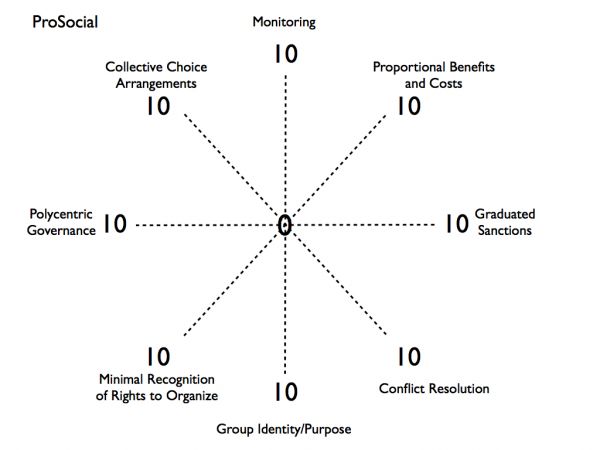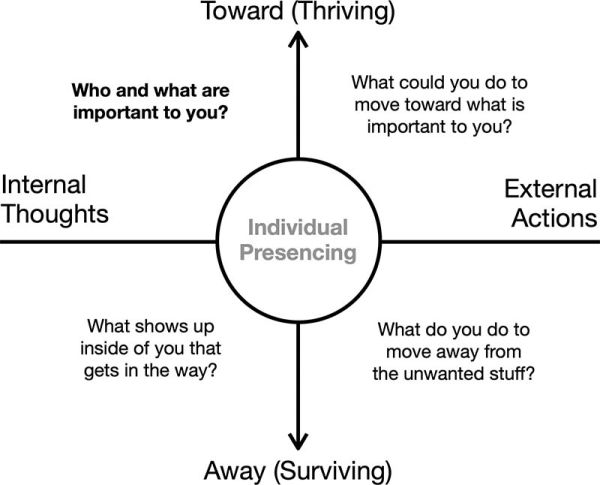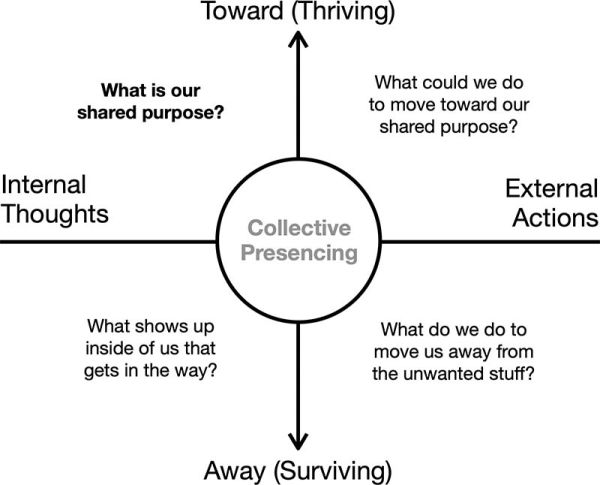Prosocial
Prosocial is a community of practice oriented toward the welfare of others and society as a whole. It is a method for helping any group, anywhere in the world, work better together. It teaches us how to develop and act on our collective consciousness with purpose. It brings together cognition, cooperation, and culture into a flexible framework that can be used to help groups improve collaboration and cooperation in different contexts. The practice is known for mitigating the spread of the Ebola virus in Sierra Leone, Africa.
The Three Considerations[edit]
Prosocial is executed through what is known as the ARC (Awareness, Relationships, Culture) Process, which is based on these three considerations:
- Awareness of our internal thoughts
- The quality of our Relationships
- The Cultural agreements we create
ACT Matrix[edit]
The underlying framework of Prosocial is the ACT (Acceptance & Commitment Training) Matrix, a graphical user interface to developing psychological flexibility. It is based on learning to discriminate between direct experiencing with internal thoughts, feelings and the senses, and external actions in the world (vertical line), and then the idea of sorting behavior into two directions called Towards and Away. The diagrams below reflect a version of Prosocial used with co-creation groups that already have a general shared vision, usually starting at the top left quadrant (Towards, Internal), then moving out from there.
Prosocial matrixes (for co-creation)[edit]
Collective ACT Matrix[edit]
Core Design Principles[edit]
Prosocial is based on eight Core Design Principles that are needed by most groups whose members must work together to achieve common goals. These principles are based on Elinor Ostrom's core design principles. Learn more about these principles in detail here.
[edit]
A group functions best when its members clearly understand its purpose and perceive that purpose as worthwhile. A group also functions best when it offers a strong shared identity that helps group members understand who is in or out of the group, increases pride and pleasure in belonging, and guides and coordinates behavior through shared norms and values.
- Key behaviors: Continuous informal and formal consideration and use of purpose in group activities. Clarify who is in the group (and who is not). Establish clear criteria for membership.
- Key outcomes: Members understand and believe in the value of the purpose of the group. Members have a shared sense of identity, both as a sense of belonging and of caring for others in the group.
- Key assessment question: To what extent do group members feel a sense of belonging and shared purpose with the group?
- Key planning questions: What do we most care about? How can we create a sense of caring, belonging, and safety in the group?
- Example methods: At its core, implementing principle 1 involves continual reflection on purpose and the use of group purpose as a guide for daily action. Members can facilitate reflection by working with strengths-based questions, such as “What are we doing at our best?” or using tools such as the Collective Matrix. Outputs include mission, vision, and values statements, though these are less important than continual reflection on the direction in which the group is going.
Core Design Principle 2: Equitable Distribution of Contributions and Benefits[edit]
For groups to function well, the effort and other forms of contribution required of its members, and the benefits of that effort, need to be distributed fairly.
- Key values: Equity.
- Key behaviors: Pay attention to individual costs and benefits and balance them appropriately.
- Key outcomes: Group members feel valued and rewarded for their contributions.
- Key assessment question: To what extent are the demands and benefits of participating in this group distributed equitably among its members?
- Key planning question: How will we ensure fairness in this group?
- Example methods: There are a variety of tools one can use to encourage the fair distribution of contributions and benefits. Begin by ensuring role clarity and transparency. From there, create channels for the open discussion of fairness and grievances; include training in communication skills to encourage assertiveness (so those who perceive unfairness can come forward) and the ability to listen to multiple perspectives (so those in management or those who may be benefiting from unfair structures can hear the concerns and respond).
Core Design Principle 3: Fair and Inclusive Decision Making[edit]
Robust evidence in psychology shows that the motivation, commitment, and long-term well-being of people comes from giving them control over their own actions.
- Key values: Individual self-determination (empowerment), making good decisions.
- Key behaviors: Collective choice processes—that is, including group members in all decisions that affect them (for example, consent-based decision making).
- Key outcomes: Members know their interests and perspectives have been considered fairly and efficiently.
- Key assessment question: To what extent do group members feel involved in making the decisions that affect them?
- Key planning question: How will we decide in a way that involves those who need and want to be involved?
- Example methods: Principle 3 can take the form of formal processes of consent-based decision making. But in some circumstances, such as those involving very large groups or corporate settings, consultation with a designated leader or representative, fair informal systems of voting, or even the opportunity to make objections (veto powers) can be enough and can even be more efficient.
Core Design Principle 4: Monitoring Agreed Behaviors[edit]
Monitoring is often better performed by peers as part of the normal interaction of group members.
- Key values: Transparency.
- Key behaviors: Processes to enhance the visibility of behaviors of group members to each other.
- Key outcomes: Misbehaviors are quickly detected at low cost to the group using processes such as pairing people with peers to whom they are accountable.
- Key assessment question: To what extent do group members know what others in the group are doing?
- Key planning questions: How can we be aware of what each other is doing? How can our behaviors be transparent?
- Example methods: Meetings, reporting, role swapping, and other activities that help group members notice and assess what others are doing.
Core Design Principle 5: Graduated Responding to Helpful and Unhelpful Behavior[edit]
Effective groups have in place responses to transgressions, including open conversation to find out what happened, sanctions, or even, ultimately, exclusion from the group. Implementing this core design principle begins with creating a shared intent to respond to behavior, not to ignore it either because doing so risks conflict or because one does not have sufficient time.
- Key values: Learning, compassion, competence.
- Key behaviors: Responding at an appropriate level of intensity to either encourage or discourage behaviors that are contributing to or detracting from cooperation.
- Key outcomes: Group members feeling valued and appreciated, feeling empowered to respond to transgressions, and having shared valuing and a commitment to high performance in the context of responding compassionately to mistakes.
- Key assessment questions: If someone behaves in a way that is unhelpful or disruptive in this group, to what extent do people respond appropriately to discourage that behavior? If someone behaves in a way that is helpful or cooperative in this group, to what extent do people respond appropriately to encourage that behavior?
- Key planning question: How should we respond to one another to encourage cooperation and discourage unhelpful behaviors?
- Example methods: Creating clear agreements for consequences, buddy systems, and coaching-based conversations about performance help promote cooperative behaviors and discourage uncooperative behaviors.
Core Design Principle 6: Fast and Fair Conflict Resolution[edit]
Plan for conflicts and their resolution from the beginning, even if conflict seems unlikely in the future.
- Key values: Respect, acceptance, courage.
- Key behaviors: Processes and skills for resolving differences in perspectives and aims.
- Key outcomes: Timely resolution or accommodation of differences in ways that honor individual interests and perspectives while preserving group effectiveness.
- Key assessment questions: How are conflicts usually resolved in this group, if at all? Are these processes fast and fair?
- Key planning question: How should we resolve the inevitable conflicts and differences that will arise within and between groups that are authentic?
- Example methods: There are many methods that support fast and fair conflict resolution, including the development of listening and assertiveness skills and the creation of a role for trusted impartial mediators, a judicial committee with rotating membership, and an escalation process that goes from self-reflection to one-on-one conversation to mediated conversations or even arbitration.
Core Design Principle 7: Authority to Self-Govern (According to Principles 1–6)[edit]
The focus shifts from the internal social organization of the group toward external relation.
- Key values: Group autonomy.
- Key behaviors: The group as a whole takes responsibility for self-management.
- Key outcomes: The group has the authority and capability to manage principles 1 through 6 to fulfill its purpose (without excessive interference from other groups with different purposes).
- Key assessment question: Does the group have authority to govern itself without excessive interference from outside the group?
- Key planning questions: How can we take responsibility for managing our own affairs? How should we lead and how should we protect ourselves from undue influence from outside the group?
- Example methods: Sociocracy, Holacracy, Open Participatory Organization (OPO) and other approaches to creating self-managing teams enshrine a group’s authority to self-govern.
Core Design Principle 8: Collaborative Relations with Other Groups (Using Principles 1–7)[edit]
A metaprinciple that allows all the other principles to be scaled to groups of groups.
- Key values: Systemic effectiveness.
- Key behaviors: A group cooperates with other groups in a system that embodies principles 1 through 7.
- Key outcomes: Group relations throughout the system of interest embody principles 1 through 7. This is the concept of polycentric governance we introduced in the previous chapter.
- Key assessment questions: Does the group have purposeful, equitable, inclusive, transparent, responsive, harmonious, and autonomy-supportive relations with other groups? Does the group primarily serve its own interests, or those of its larger context?
- Key planning questions: How can we have better relations with other groups? How can we contribute to building whole systems that work?
- Example methods: As a metaprinciple that includes the first seven principles at any hierarchical level, this principle does not have methods of its own. However, when considered at the level of groups of groups, this principle is deemed to be working well when a group has systems for reporting to other groups, or for coordinating between groups in a purposeful way. For example, with sociocracy, every subgroup is related to every other subgroup through two roles that ensure the interests of both groups are represented. This “double linking” goes a long way toward encouraging purposeful, equitable, inclusive, transparent, responsive, harmonious, and autonomy-supportive relations between groups.
Prosocial evaluation[edit]
Rate how well your group implements each of these principles (very poor = toward center, very good = toward edge). Join the ratings to create a Core Design Principle wheel.

Prosocial ARC Process 5 Main Modules[edit]
The Prosocial ARC Process teaches us how to develop and act on our collective consciousness with purpose. It includes 5 main modules:
Module 1. Measurement to diagnose what is going on and evaluate change[edit]
Module 2. A process for defining the individual interests[edit]
[edit]
Module 4. The Core Design Principles[edit]
Module 5. Goal setting and monitoring for change[edit]
Standard pathway[edit]
The general Prosocial approach consists of the following steps:
Before First Session
1. Assess individual and group aspects using the Prosocial survey (https://prosocial.world) to evaluate and inform change.
At First Session
2. Implement the individual matrix in a brief and general form with the emphasis on the group simply getting used to the structure. This run-through doesn’t need to focus on the group and could simply start with an invitation like “Jot down two or three things that matter most to you in the bottom right.
3. Spend most of the session doing the collective matrix to build an initial awareness of group purpose and identity, as well as other aspects of group functioning.
Between First and Second Sessions
4. Collect perceptions and stories about the Core Design Principles using the survey available at https://prosocial.world.
At Second Session
5. Discuss the Core Design Principles survey results.
6. Review how implementation of the Core Design Principles might be improved, and any barriers to improvement.
7. Set short- to medium-term goals.
8. Prioritize and plan actions.
Between Second and Final Sessions
9. Implement planned changes.
At Final Session
10. Review progress (including reminding the group of the shared identity and purpose emerging from the collective matrix). Possibly use the collective matrix to have the group reflect on the reasons for its rate of progress implementing the Core Design Principles.
11. Problem solve how to improve the application of the Core Design Principles.
12. Commit to implementing them, and plan for continuous improvement.
After Final Session and Going Forward
13. Measure individual and group aspects to evaluate change.

